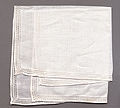Linen
Linen is a textile made from the fibers of the flax plant. It is laborious to manufacture, but the fiber is very strong, absorbent, and dries faster than cotton. Garments made of linen are valued for their exceptional coolness and freshness in hot and humid weather.
History[edit]
The history of linen is as old as the history of man. The use of linen was already known in prehistoric times. Fragments of straw, seeds, fibers, yarns, and various types of fabrics dating to about 8000 BC have been found in Swiss lake dwellings. Dyed flax fibers found in a cave in Georgia suggest the use of woven linen fabrics from wild flax may date back even earlier to 36,000 BP.
Production[edit]
Linen fabric is made from the cellulose fibers that grow inside of the stalks of the flax plant, or Linum usitatissimum, one of the oldest cultivated plants in human history.
Uses[edit]
Linen is used in a wide range of products from bed and bath fabrics, home and commercial furnishing items, apparel items to industrial products. It has a very cool and fresh feel making it suitable for clothing and for sheets in hot weather.
See also[edit]
|
|
|
Linen[edit]
-
Handkerchief
-
Linen cloth
-
Textielmuseum cabinet
-
A bag of white linen, unopened. Contains rolls of linen only. Foundation deposit, Heb Sed Chapel at Lahun, Fayum, Egypt. 12th Dynasty. The Petrie Museum of Egyptian Archaeology, London
-
Prices edict grades
-
Ancient Coptic material
-
Green Pleated Linen Dress, 'Irish Moss' by Sybil Connolly - Full Length Back
-
Labeled stem for poster copy new
-
Linum usitatissimum - Köhler’s Medizinal-Pflanzen
-
Linen Mechanical Harvesting - Summer 2009 - Belgium
-
Rhof flachsbearbeitung
-
Bäuerliche Leinenweberei - 4. Die Herstellung von Leinwand
Ad. Transform your life with W8MD's Budget GLP-1 injections from $75


W8MD offers a medical weight loss program to lose weight in Philadelphia. Our physician-supervised medical weight loss provides:
- Weight loss injections in NYC (generic and brand names):
- Zepbound / Mounjaro, Wegovy / Ozempic, Saxenda
- Most insurances accepted or discounted self-pay rates. We will obtain insurance prior authorizations if needed.
- Generic GLP1 weight loss injections from $75 for the starting dose.
- Also offer prescription weight loss medications including Phentermine, Qsymia, Diethylpropion, Contrave etc.
NYC weight loss doctor appointmentsNYC weight loss doctor appointments
Start your NYC weight loss journey today at our NYC medical weight loss and Philadelphia medical weight loss clinics.
- Call 718-946-5500 to lose weight in NYC or for medical weight loss in Philadelphia 215-676-2334.
- Tags:NYC medical weight loss, Philadelphia lose weight Zepbound NYC, Budget GLP1 weight loss injections, Wegovy Philadelphia, Wegovy NYC, Philadelphia medical weight loss, Brookly weight loss and Wegovy NYC
|
WikiMD's Wellness Encyclopedia |
| Let Food Be Thy Medicine Medicine Thy Food - Hippocrates |
Medical Disclaimer: WikiMD is not a substitute for professional medical advice. The information on WikiMD is provided as an information resource only, may be incorrect, outdated or misleading, and is not to be used or relied on for any diagnostic or treatment purposes. Please consult your health care provider before making any healthcare decisions or for guidance about a specific medical condition. WikiMD expressly disclaims responsibility, and shall have no liability, for any damages, loss, injury, or liability whatsoever suffered as a result of your reliance on the information contained in this site. By visiting this site you agree to the foregoing terms and conditions, which may from time to time be changed or supplemented by WikiMD. If you do not agree to the foregoing terms and conditions, you should not enter or use this site. See full disclaimer.
Credits:Most images are courtesy of Wikimedia commons, and templates, categories Wikipedia, licensed under CC BY SA or similar.
Translate this page: - East Asian
中文,
日本,
한국어,
South Asian
हिन्दी,
தமிழ்,
తెలుగు,
Urdu,
ಕನ್ನಡ,
Southeast Asian
Indonesian,
Vietnamese,
Thai,
မြန်မာဘာသာ,
বাংলা
European
español,
Deutsch,
français,
Greek,
português do Brasil,
polski,
română,
русский,
Nederlands,
norsk,
svenska,
suomi,
Italian
Middle Eastern & African
عربى,
Turkish,
Persian,
Hebrew,
Afrikaans,
isiZulu,
Kiswahili,
Other
Bulgarian,
Hungarian,
Czech,
Swedish,
മലയാളം,
मराठी,
ਪੰਜਾਬੀ,
ગુજરાતી,
Portuguese,
Ukrainian










